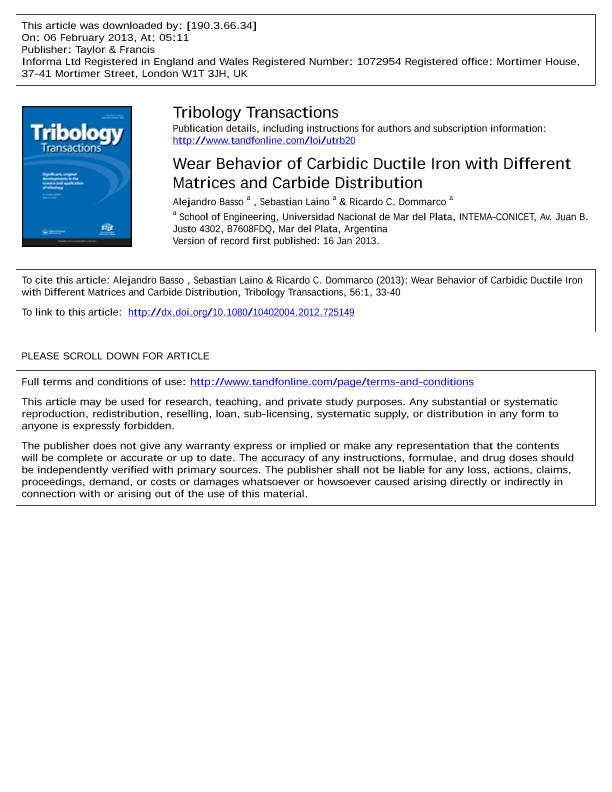Mostrar el registro sencillo del ítem
dc.contributor.author
Basso, Alejandro Daniel

dc.contributor.author
Laino, Sebastian

dc.contributor.author
Dommarco, Ricardo

dc.date.available
2015-11-02T13:57:20Z
dc.date.issued
2013-01-16
dc.identifier.citation
Basso, Alejandro Daniel; Laino, Sebastian; Dommarco, Ricardo; Wear behaviour of carbidic ductile iron with different matrices and carbide distribution; Taylor & Francis; Tribology Transactions; 56; 1; 16-1-2013; 33-40
dc.identifier.issn
1040-2004
dc.identifier.uri
http://hdl.handle.net/11336/2607
dc.description.abstract
Just like other properties, wear resistance is entirely dependent on materials microstructure, which, in turn, is related to the chemical composition and solidification rate that controls phases type, size, amount and dispersion. Depending on the tribosystem, the abrasive wear resistance of ductile iron (DI) may be improved by heat treatment as well as by reinforcing the matrix with hard particles like carbides, typically obtained by alloying with elements such as chromium. The solidification rate mainly depends on wall thickness and mould characteristics. In ductile iron, the solidification rate affects microstructural characteristics, such as nodule size, nodule count, carbide size and distribution and matrix refinement, also including the last to freeze (LTF) amount, size and distribution. This study evaluates the influence of the wall thickness (12.5, 25, 50 and 75 mm) on the abrasion resistance and impact toughness of DI with different matrices reinforced with carbides. Carbidic structures were obtained by alloying the melt with Cr; and the different types of matrices such us pearlitic, martensitic and ausferritc (CADI) were obtained under as cast conditions or by heat treatment. The results reflect the influence of cooling rate on the microstructural characteristics and its relationship with the mechanical properties, particularly the abrasive wear resistance. It was demonstrated that, under the present experimental conditions, the highest carbide content and matrix hardness, obtained from the 12.5 mm thick part with a martensitic matrix, resulted in the highest abrasion resistance.
dc.format
application/pdf
dc.language.iso
eng
dc.publisher
Taylor & Francis

dc.rights
info:eu-repo/semantics/openAccess
dc.rights.uri
https://creativecommons.org/licenses/by-nc-sa/2.5/ar/
dc.subject
ABRASIVE WEAR
dc.subject
CARBIDES
dc.subject
IRON
dc.subject
METALLURGICAL ANALYSIS
dc.subject
XRD
dc.subject.classification
Ingeniería de los Materiales

dc.subject.classification
Ingeniería de los Materiales

dc.subject.classification
INGENIERÍAS Y TECNOLOGÍAS

dc.subject.classification
Físico-Química, Ciencia de los Polímeros, Electroquímica

dc.subject.classification
Ciencias Químicas

dc.subject.classification
CIENCIAS NATURALES Y EXACTAS

dc.title
Wear behaviour of carbidic ductile iron with different matrices and carbide distribution
dc.type
info:eu-repo/semantics/article
dc.type
info:ar-repo/semantics/artículo
dc.type
info:eu-repo/semantics/publishedVersion
dc.date.updated
2016-03-30 10:35:44.97925-03
dc.journal.volume
56
dc.journal.number
1
dc.journal.pagination
33-40
dc.journal.pais
Reino Unido

dc.journal.ciudad
Londres
dc.description.fil
Fil: Basso, Alejandro Daniel. Universidad Nacional de Mar del Plata. Facultad de Ingenieria; Argentina. Consejo Nacional de Investigaciones Científicas y Técnicas. Centro Científico Tecnológico Mar del Plata. Instituto de Investigación en Ciencia y Tecnología de Materiales (i); Argentina
dc.description.fil
Fil: Laino, Sebastian. Universidad Nacional de Mar del Plata. Facultad de Ingenieria; Argentina. Consejo Nacional de Investigaciones Científicas y Técnicas. Centro Científico Tecnológico Mar del Plata. Instituto de Investigación en Ciencia y Tecnología de Materiales (i); Argentina
dc.description.fil
Fil: Dommarco, Ricardo. Universidad Nacional de Mar del Plata. Facultad de Ingenieria; Argentina. Consejo Nacional de Investigaciones Científicas y Técnicas. Centro Científico Tecnológico Mar del Plata. Instituto de Investigación en Ciencia y Tecnología de Materiales (i); Argentina
dc.journal.title
Tribology Transactions

dc.relation.alternativeid
info:eu-repo/semantics/altIdentifier/url/http://www.tandfonline.com/doi/abs/10.1080/10402004.2012.725149
dc.relation.alternativeid
info:eu-repo/semantics/altIdentifier/doi/http://dx.doi.org/10.1080/10402004.2012.725149
Archivos asociados
